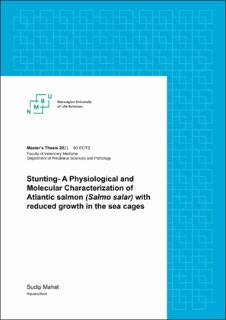| dc.description.abstract | Atlantic salmon (Salmon salar) has become the dominating fish species in Norwegian aquaculture industry. Having an anadromous life cycle, salmon spend the first part of their lifecycle in freshwater, then migrates to the sea before returning to freshwater to spawn. Before migration to seawater, the freshwater parr undergo series of morphological, physiological, and behavioural changes known as smoltification, which pre-adapts the fish (now called smolts) for life in the sea. Typically, Gh, cortisol, and thyroxine together with tshbb peak during smoltification before returning to baseline levels around sea transfer. In nature, the hormone profile observed during salmon smoltification determines the preferred or optimal window for sea transfer.
Stunting where smolts stop growing after sea transfer has been a major economic and welfare issue for the industry. The aim of this thesis was to conduct molecular and physiological characterization of stunts to provide insight about mechanism behind stunting. In total 30 fish were sampled eight weeks after transfer to sea cages. The fish were categorized into stunts (20) and normal growing fish (10) based on weight and condition factor. Plasma Gh levels were measured using ELISA. Gene expression of all pituitary hormone, and gill Na+K+-ATPase were investigated using qPCR. Plasma levels of Gh was significant elevated in stunts. The qPCR results from pituitaries showed significant upregulation of gh, pomca2, tshbb in stunts. In contrast, smlta, prl and tshba were down regulated in stunts. The expression levels of gill nka3 and nkab1 were significantly downregulated in stunts. Based on the gene expression pattern and elevated levels of plasma Gh, the stunts might have been transferred prematurely to sea. Furthermore, as the plasma osmolality in stunts were the same as in normal growing fish it strongly suggests that stunts can maintain their ability to hypoosmoregulate for a period after sea transfer. | en_US |

